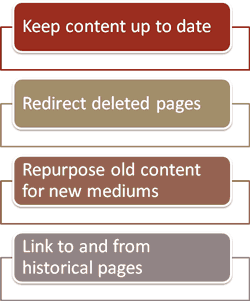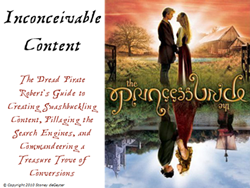 Much like life, websites have to adapt over time. When they don’t, they risk becoming stagnant, outdated, stale, and boring. As times change, so should your content. Content that was once relevant becomes irrelevant or in need of an update, old products get dumped in favor of new products, and data becomes outdated and needs to be replaced.
Much like life, websites have to adapt over time. When they don’t, they risk becoming stagnant, outdated, stale, and boring. As times change, so should your content. Content that was once relevant becomes irrelevant or in need of an update, old products get dumped in favor of new products, and data becomes outdated and needs to be replaced.
There are any number of reasons why content needs to be changed, freshened up, or removed altogether. But rarely, if ever, do you want to throw the baby out with the bath water. Something can usually be salvaged. Previously valuable content can be made valuable again. Here are four ways you can keep good content alive, even when it’s old.
Keep content up to date
Keeping your content up-to-date may sound like a simple task; but, the larger the site, the more difficult it is. Sites with hundreds or thousands of pages often have a lot of little hidden gems that can easily become stale or irrelevant. Over time, you see products and services change. A simple reference to an old pricing structure or outdated way of doing things can really throw a wrench in the works for the reader. Conflicts and contradictions breed mistrust.
Failing to find and correct these nuggets will send your readers a message that perhaps you are stale and irrelevant as well. So, spending time on a regular basis, perhaps yearly, reviewing all your editorial content and brushing it up to keep it current is an important item to put on your task list.
Redirect deleted pages
Pages on websites often get moved or deleted over time. Perhaps you are restructuring your information architecture, removing services that you no longer offer, or deleting tutorials that have become obsolete. Just because this content is considered old, doesn’t mean that it can’t still work for you.
Simply adding “301 redirects” or a building a custom “404” page can capture that traffic and send them to other areas of your site. This allows them to stick around long enough to see if you still have something that will meet their needs, even though you no longer have exactly what they want.
Adding redirects allows you to keep visitors on your site if they have arrived, say, from a bookmarked page or an old page in the search results. Instead of losing those visitors, this gives you the opportunity to keep them engaged with your site, with the possibility of attracting them to your other excellent content.
 Repurpose old content
Repurpose old content
Blogs are a great place to re-purpose old content and provide an updated spin on it. If you’re running out of ideas for what to publish on your blog, you can go back several years in your archive and find old topics and discussions for which you can provide a new take.
Blog back history can give you a wealth of topics that you can pull from to create fresh, new content for your readers.
Another way to re-purpose old content is by removing excessive content from your site and moving it over to your blog. This can be necessary after years of site content build-up. This happens when you keep adding content to your site and it becomes so bloated that your readers end up spending too much time working through your site instead of being moved through the conversion process.
A couple months back, I worked on the Information Architecture for a client, and they had this very problem. We were able to take dozens of pages of content and move it off of their main site onto their blog. The content was good, but it was excessive. This hindered the conversion process, making the site both convoluted and confusing at the same time. By moving this stuff to the blog, the main site was better able to do the job of selling and the blog became the avenue of informing readers.
Link to historical pages
Content, especially blog content, often gets buried after months and years of time passing. But that doesn’t necessarily mean the content isn’t valuable or even needs to be re-written.
What you can do is write new content that links to this valuable content that was written long ago. You’re giving your readers something fresh, while linking to something historical, that you can use to make your point or provide more detailed information for the reader to peruse at their leisure.
Take advantage of any area of content that allows you to link to another page that provides more information. The web isn’t a brochure, it’s more like a choose-your-own-adventure novel. That historical content can be a goldmine of information, provided you’re giving your new readers a way to access it.
Good content never has to die. If you’re treating it right, it never will. New people are coming to your site every day. These people have not had the benefit of reading all your past or historical stuff. No need to let it go to waste. Instead, keep it alive… and keep it working for you.
 This post was inspired from The Princess Bride themed presentation I gave in early 2010 at SEMpdx’s Searchfest titled Inconceivable Content: The Dread Pirate Robert’s Guide to Creating Swashbuckling Content, Pillaging the Search Engines, and Commandeering a Treasure Trove of Conversions. If you enjoyed this post you also might enjoy other posts inspired from the same. Search for “inconceivable content” on this blog to find them all.
This post was inspired from The Princess Bride themed presentation I gave in early 2010 at SEMpdx’s Searchfest titled Inconceivable Content: The Dread Pirate Robert’s Guide to Creating Swashbuckling Content, Pillaging the Search Engines, and Commandeering a Treasure Trove of Conversions. If you enjoyed this post you also might enjoy other posts inspired from the same. Search for “inconceivable content” on this blog to find them all.

One Response to Don’t Let Good Content Die – 4 Ways to Keep It Alive